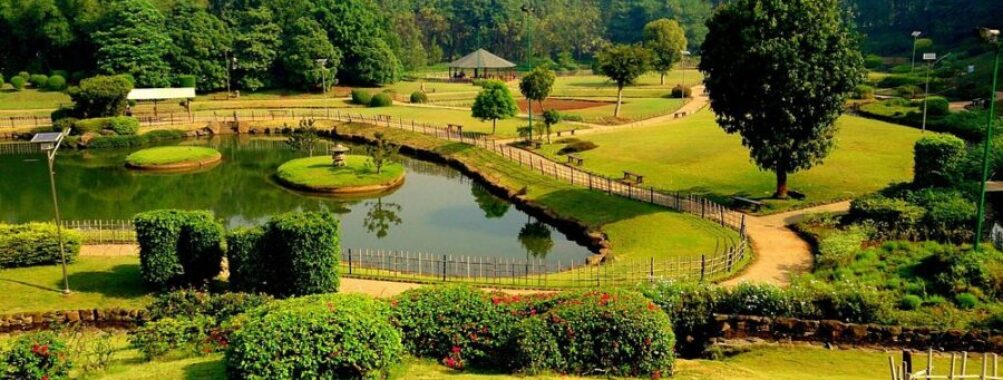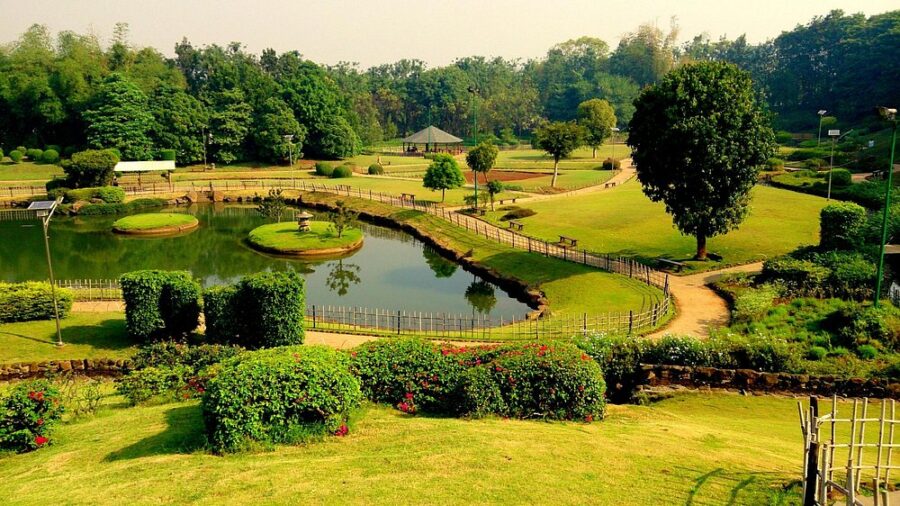
Pune-Okayama Friendship Garden
Table of Contents
History and Significance

If you’re wandering through Pune and want to experience something truly serene and steeped in meaning, the Pune-Okayama Friendship Garden is a place you can’t miss. This garden, also known as Pu La Deshpande Udyan, is a living symbol of the friendship between Pune and its sister city, Okayama in Japan. Born out of a desire to celebrate the cultural ties and solidarity between these two cities, the garden draws deep inspiration from the famous 300-year-old Korakuen Garden in Okayama, one of Japan’s Three Great Gardens. Established in the early 2000s—officially inaugurated around 2001-2006—the garden transformed a once neglected quarry area into a lush, tranquil retreat spanning about 10 acres.
The name itself carries weight, honoring Purushottam Laxman Deshpande, or Pu La Deshpande, a beloved Marathi writer and humorist who embodied wit, warmth, and cultural depth. So, when you visit, you aren’t just wandering a garden—you’re stepping into a space where Pune’s cultural heritage mingles gracefully with Japanese garden philosophy. The design symbolizes peace, harmony, and the spirit of collaboration, reflecting a shared commitment to friendship that blossomed from Pune’s sister city relationship, initiated in 1984 and blossoming decades later into this living masterpiece.
Main Attractions and Activities
Now, picture this: a garden where every corner invites you to pause, breathe, and absorb natural beauty carefully crafted through Japanese garden artistry. The steep hills of the quarry site have been sculpted into gentle lawns, shaded bamboo groves, serene ponds filled with koi fish, and charming stone pathways. You’ll cross elegant bridges arching over flowing water streams that ripple gently as if whispering tales of Indo-Japanese friendship.
The garden blends Japanese elements—like stone lanterns, Zen meditation spaces, and meticulously sculpted bushes—with Indian horticultural touches. Seasonal flowers burst into color through spring, summer, autumn, and winter, ensuring that every visit offers a fresh palette and sensory delight. If you’re into capturing moments, photography enthusiasts love this place for its interplay of light, water reflections, and serene settings.
Beyond simple walks, there’s a rich calendar of cultural events, workshops, and festivals held here—think bonsai exhibitions, traditional tea ceremonies, and yoga sessions in the Zen corner. These events aren’t just performances; they’re invitations to dive deep into cultural exchange, nature celebration, and community bonding. So if you want your experience topped with something memorable, check the garden’s schedule, and you might catch a festival or workshop that enriches your entire visit.
Visitor Experience
Walking into the Pune-Okayama Friendship Garden is like slipping into a peaceful world tucked away from Pune’s urban hum. The atmosphere is calm yet alive—there’s space for silent meditation by the koi pond, but also lively chatter from families enjoying picnics on the lawns. Visitors talk about how this garden invites you to slow down and reconnect—with nature and yourself.
I remember chatting with a local guide who shared how the garden’s design philosophy embraces “wabi-sabi,” the beauty found in simplicity and imperfection. You might feel that gentle impermanence as you stroll under bamboo shadows or watch leaves drift on the water. As a visitor, you get the distinct sense that this isn’t just a tourist spot but a well-loved community haven.
The garden caters well to different visitor types—romantic couples, nature lovers, families, and even solo contemplators. And yes, since the garden is fairly large and has some gentle slopes, comfortable shoes are a must if you want to explore fully without tiring out early. Mornings and late afternoons bring a special light that’s perfect for reflection or photography, but the garden remains welcoming throughout the day.
Tips for Visitors
If you’re planning a visit, here’s what you’ll want to keep in mind to make the most of it:
-
Go early or late in the day: To avoid crowds and catch the softest light for photos or peaceful walks.
-
Wear comfortable shoes: There’s a bit of walking and some gentle inclines.
-
Bring a camera or phone: The garden’s scenery is a dream for photographers.
-
Check event schedules: Time your visit to coincide with festivals, bonsai workshops, or tea ceremonies for a richer cultural dip.
-
Pack some water and a light snack: While the garden has some kiosks, options can be limited.
-
Visit in different seasons: Each season paints the garden differently—from blooming spring flowers to tranquil winter serenity.
-
Respect local customs: The garden is a peaceful place; keep noise low, and avoid littering.
-
Accessibility: While paths are paved and manageable, if you have mobility issues, contacting the garden beforehand can help.
These little details will ensure your visit feels more like a treasured day out than just a casual stroll.
Accessibility and Facilities
The garden is quite visitor-friendly. Located on Sinhagad Road (near Tanaji Malusare Road), it’s reachable by car, taxi, and reasonably well-served by public transport, though a bit of walking is involved. Once inside, paved pathways and gentle slopes make for an easy walk, though steep inclines exist in some parts—so keep mobility needs in mind.
Facilities include clean restrooms and resting benches scattered throughout, perfect for catching your breath. Since the garden is all about gentle natural immersion, you won’t find flashy amenities, but everything you need for a comfortable visit is there. It’s a good idea to plan your transport, as parking can get busy on weekends and public transit stops are a short walk away.
Accessibility is better than many open gardens in India, thanks to careful design blending nature with visitor comfort, but those with serious mobility issues should inquire about specific routes and assistance options before coming. Overall, the garden balances natural authenticity with functionality well enough so that most visitors leave feeling cared for and respected.
Unique Features
What really sets the Pune-Okayama Friendship Garden apart is its bold fusion of two rich cultures in one cohesive space. Inspired by Japan’s ancient Korakuen Garden but brought to life with local Indian flair, it’s a rare example of international cultural synergy in a green urban space.
The garden’s name, honoring Pu La Deshpande, also infuses it with deeper local cultural resonance, linking Maharashtra’s literary heritage with Japanese gardening traditions. The philosophy behind the garden is one of peace, meditation, and harmony—not just an aesthetic goal but a living ethic.
Seasonal flower displays, koi ponds, bamboo groves, stone lanterns, and rustic bridges are all arranged with mindful attention to spatial balance and the traditional Japanese Yin-Yang principle. The garden even supports sustainable practices, using organic fertilizers and water-conservation irrigation, which ties into the broader global and local push for eco-awareness.
On any given day, you might stumble upon a tea ceremony or a bonsai workshop, adding layers of hands-on cultural engagement rare in typical city parks. And because it was created from an old quarry site, the very landscape speaks of renewal and transformation—perfect symbolism for a friendship garden.
Overall Impressions
Honestly, the Pune-Okayama Friendship Garden is one of those hidden gems that you fall in love with the moment you step inside. It’s peaceful without being dull, culturally rich without being overpowering, and natural without feeling uncontrolled. It symbolizes the best of cultural friendship and urban renewal through a living, breathing garden that feels both timeless and timely.
Whether you’re a local craving a serene escape, a tourist seeking something meaningful beyond monuments, or a culture buff wanting to witness Indo-Japanese harmony, this garden has a quiet magic. It’s not just about flowers and trees but about spirit and friendship embodied in nature’s language.
You’ll leave refreshed, your senses calmed, and your heart warmed by the thought of two cities thousands of miles apart sharing this beautiful embrace of peace and friendship in a garden tucked into Pune’s bustling cityscape.
Pros and Cons
| Pros | Cons |
|---|---|
| Largest Japanese garden outside Japan | Limited food and drink options on-site |
| Strong cultural symbolism and Indo-Japanese ties | Some slopes may be challenging for mobility |
| Beautiful seasonal flowers and landscapes | Weekends can get crowded |
| Peaceful atmosphere, perfect for meditation | Few shaded areas besides the bamboo groves |
| Hosts cultural events like bonsai workshops and tea ceremonies | Public transport stops are a short walk away |
| Eco-friendly maintenance practices | No major commercial facilities |
If you want a garden experience that’s more than just pretty flowers—a place where every rock, stream, and flower tells a story of friendship and harmony—the Pune-Okayama Friendship Garden is ready to surprise and delight you. Make sure to linger long, soak in the vibe, and take away more than just photos: a piece of peace from two cities united by culture and respect.
Location
Places to Stay Near Pune-Okayama Friendship Garden
Find and Book a Tour
Explore More Travel Guides
No reviews found! Be the first to review!